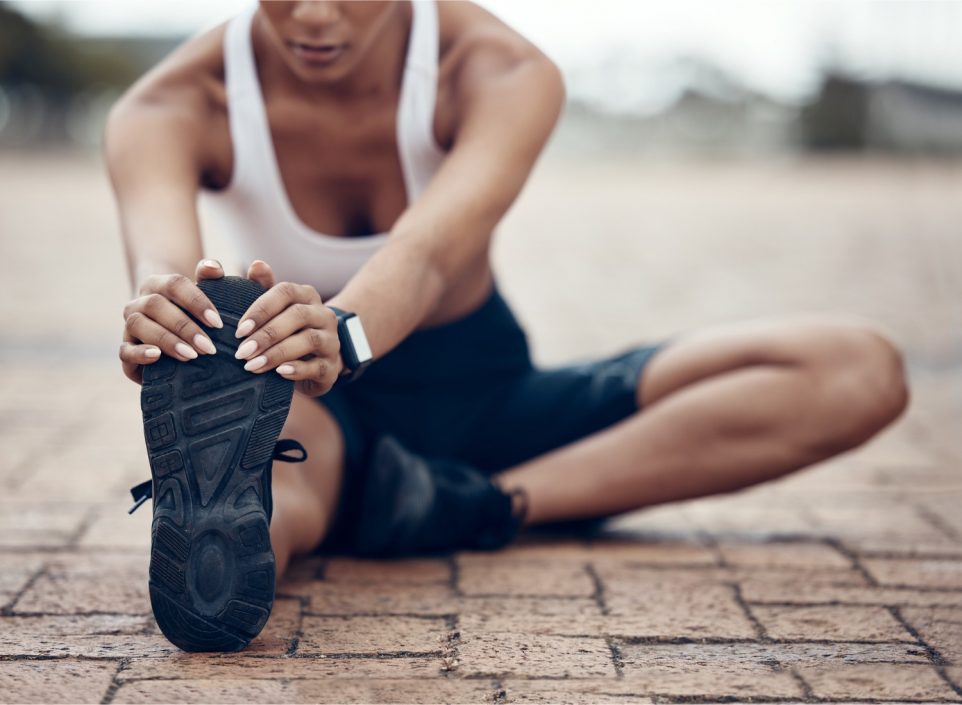Does Stretching Help Sore Muscles? 5 Tips for Rapid Muscle Recovery

After a tough workout or strenuous run, you may experience the pain and discomfort of sore muscles despite wearing the correct running shoes and running shorts. One way you can alleviate and possibly prevent these aches and pains is through stretching. It’s a powerful tool to help you recover faster and return to your active lifestyle.
In this article, we will answer the burning question, “Does stretching help relieve sore muscles?” We’ll also share five amazing tips for rapid muscle recovery so you can put all of your energy into your fitness routine rather than the aches and pains that can follow.
Understanding Sore Muscles
The science behind muscle soreness
Muscle soreness, also known as delayed onset muscle soreness (DOMS), is generally caused by microscopic damage to muscle fibers during physical activity.
Common causes of sore muscles
Intense exercise, overexertion, and unfamiliar movements can all lead to muscle soreness.
The Role of Stretching in Muscle Recovery
How stretching affects muscle tissue
Stretching helps to improve muscle flexibility, increase range of motion, and promote muscle recovery by reducing muscle stiffness and tension.
Stretching and improved circulation
Stretching increases muscle blood flow, delivering essential nutrients and oxygen while removing waste products and aiding muscle recovery.
Stretching vs. muscle tightness and soreness
Stretching helps alleviate muscle tightness and soreness by enhancing muscle relaxation and reducing muscle tension.
Types of Stretching and Their Impact on Sore Muscles
Static stretching: What it is and how it helps
Static stretching involves holding a stretch for a prolonged period, which helps to lengthen the muscle fibers and improve flexibility.
Dynamic stretching: How it differs and its benefits
Dynamic stretching involves moving through a range of motion, which helps to activate muscles and improve muscle performance.
PNF (Proprioceptive neuromuscular facilitation) stretching: An overview
PNF stretching combines static stretching and muscle contraction to improve flexibility and range of motion.
5 Key Stretching Techniques for Rapid Muscle Recovery
Stretching technique 1: Description and benefits
This technique involves performing static stretches for each major muscle group, holding each stretch for 20-30 seconds to improve flexibility and reduce muscle soreness.
Stretching technique 2: Description and benefits
Dynamic stretching helps warm the muscles, increase blood flow, and prepare the body for physical activity, reducing the risk of muscle soreness.
Stretching technique 3: Description and benefits
PNF stretching involves contracting and relaxing muscles to improve flexibility and range of motion, leading to faster muscle recovery.
Stretching technique 4: Description and benefits
Foam rolling, a form of self-massage using a foam roller, helps to release muscle tension and improve blood circulation, aiding in muscle recovery.
Stretching technique 5: Description and benefits
Active recovery exercises, such as light jogging or biking, help to increase blood flow and flush out metabolic waste from the muscles, promoting faster muscle recovery.
Additional Tips to Enhance Muscle Recovery
Hydration and nutrition: Their role in muscle recovery
Staying hydrated and consuming a balanced diet of protein, carbohydrates, and essential nutrients supports muscle recovery and reduces muscle soreness.
Rest and sleep: Why they matter
Adequate rest and quality sleep are crucial for muscle recovery, allowing the body to repair and rebuild muscle tissues.
Massage and foam rolling: Do they help?
Massage and foam rolling can help relieve muscle tension, improve circulation, and promote muscle recovery. Using massage oil during these techniques can enhance the experience and provide additional benefits. Some may also find relief with a traction device, which can aid in injury recovery.
Conclusion
Stretching is a powerful tool for rapid muscle recovery. By incorporating stretching into your post-workout routine, you can alleviate muscle soreness, increase flexibility, and improve overall muscle performance. Listen to your body, avoid common stretching mistakes, and seek professional advice. So, say goodbye to those post-workout aches and pains by incorporating stretching into your routine and enjoy the benefits of rapid muscle recovery.
Trustworthy Insights for You
With years of combined expertise in online publishing, OvertimeReviews embodies the lessons learned from SEO strategies to paid advertising experiences. We've navigated the highs and lows, and our goal remains clear: to equip readers with comprehensive information they can trust.
